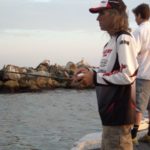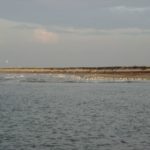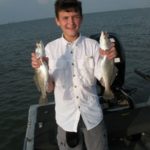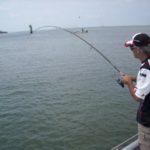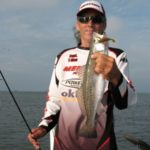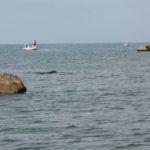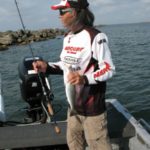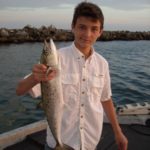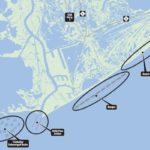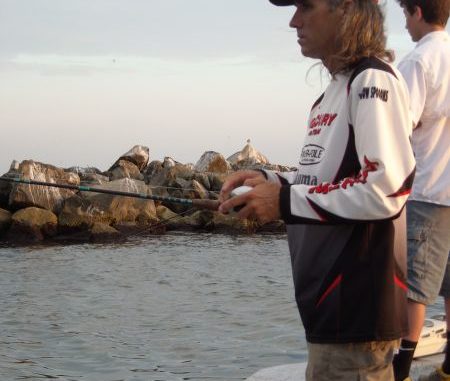
It’s been a tough year overall for trout fishermen in the Barataria system, but there are still nice trout still to be caught at Fourchon Beach and its waterbreaks. You just have to know the right approach.
So it’s been a slow season for trout. The usual summer slam we expect every year never quite materialized, and anglers and guides alike have scratched their heads, wondering if this season is an ominous portend of things to come.
Has the Gulf run out of fish? Has the BP oil spill caught up to us and decimated our speckled trout population? Has the summer magic along Louisiana’s coast worn off? Do we reduce our daily creel limits? What’s going on with our speckled trout?
Don’t push the panic button, at least not yet. The experts over at the Louisiana Department of Wildlife and Fisheries assure us our speckled trout population is healthy, juveniles are plentiful (as most of us can attest, considering the number of throwbacks) and the stock is well capable of reproducing itself.
Creel reductions or changing size limits don’t seem to be in the immediate future, but no one can predict what changes might eventually lay ahead. A spokesperson told me new data was being compiled right now, and a full stock assessment report is due to be released by the LDWF by the end of year.
Hopefully, it will hold no unpleasant surprises.
Most of us attribute the slower-than-usual trout season to the colder- and longer-than-usual winter. Throw in the change in the hydrology along much of our fishing area — especially the area affected by the closure of the MRGO in both Chalmette and Hopedale — and then add the high Mississippi River and copious rainfall, persistent west winds, the lack of a strong tropical system last season that normally floods the inland marshes with salt water and the resultant lower salinities this year, and you’ve probably got the ingredients for an off season.
If there’s good news here, it’s that such seasons are cyclical and things can pretty quickly return to normal. If there’s bad news, it’s that cycles can grow roots and establish themselves as the new normal, as in “global warming.”
Normally, the trout season begins to wind down this month, as we begin the annual transition from summer to fall. Trout start a gradual move inward — off the beaches and away from deeper-water structures off the coastline.
This month might be different, in more ways than one. If there are no tropical systems, the usual migration inside might be delayed, just as the spring and summer bite was delayed. Meaning, this might be a productive time for beach and rig fishing along the coast and in the bigger bays.
However, some anglers are reporting sooner-than-usual catches of trout in mid-range lakes and bays, indicating an early transition to the inside. And if we do get an influx of saltwater from any tropical activity, the bait and the fish will set up shop inside — and that’s where you’ll want to fish.
Beaches and barges
I recently arranged to meet Capt. T-Man Cheramie (985-677-6294) at the dock of the Fourchon Marina at daybreak. Cheramie said he had been catching some good numbers of nice trout at the beaches and barges, and he offered to take me along on a trip he’d planned with his 16-year-old grandson, Paul Danos, a junior at Central Lafourche High School.
After loading my gear aboard Cheramie’s 22-fiit Predator bay boat, he fired up the outboard and headed us toward Bayou Lafourche.
Forecasters predicted a high chance of early morning thunderstorms, and one was lighting up the morning sky in the distance ahead as it slowly moved south just off the coast.
Our initial plan was to head straight to the barges along the Fourchon Beach, but as we passed along the Belle Pass jetties I saw sparks in Cheramie’s eyes.
I could tell even before he turned around that he saw something enticing along those rocks, and once you get that kind of itch you just have to stop and scratch it.
Besides, he said, we needed to keep an eye on that nearby thunder boomer to make sure it kept moving away from us.
The Belle Pass jetties have produced some big trout and bull reds along with myriad other species through the years. Spilling directly into the Gulf as it does, anything can make its way to those rocks.
The end of the west side jetty was too much to resist, and Cheramie inched the boat close enough to cast toward the rocks and put down the anchor. Once it held, we loaded our hooks with live minnows and croakers from the baitwell and put them in harm’s way.
“Look at how clear and green the water is here,” Cheramie said. “I can almost see the bottom. This is all seawater, so we could catch anything.”
Cheramie had hardly finished speaking before the drag whined and the rod arched in young Paul’s hands, and he reeled in a fiercely resisting Spanish mackerel.
It would be one of many we’d catch in that spot. We kept a few and tossed back the rest — and since nothing else was biting and the dark skies and thunderstorms were retreating to the south of us, we resumed our journey to the barges.
A dozen rock piles
Some years ago, a dozen barges were loaded with huge rocks and purposely sunk along the coast of Fourchon Beach. Just east of Belle Pass, they were intended to serve as breakwaters to stave off beach erosion.
The metal barges themselves rusted away long ago, and only pieces remain here and there above water as reminders of their previous existence.
But the rocks remain clearly visible in a dozen evenly spaced heaps, and they have evolved into quite an underwater habitat for a variety of fish — including speckled trout and redfish.
“I catch a lot of nice-sized specks all around these barges,” Cheramie said, as he slowly trolled us within casting distance of the rocks.
The water was still green, but not nearly as clear as the water along the jetties.
“This slightly murky water is actually better,” Cheramie said. “This is more the kind of water we’ll catch reds and specks in.”
I liked the confidence in his voice and switched to a topwater bait. Both T-Man and Paul were fishing live bait under corks and finding some gafftops, hardheads and a few more Spanish mackerel.
I hoped my topwater MirrOlure would attract the attention of the right kind of fish, but all I got was a few half-hearted swats by what I suspect were small trout that weren’t old enough to make a commitment.
After circling a few barges without a single speck to show for it, Cheramie decided we’d run farther east and do some beach fishing.
Beach patrol
Fourchon Beach extends for over 12 miles eastward, all the way to Elmer’s Isle and Caminada Pass. And all of it is fishable.
On a good day, when the surf is not too rough, trout and redfish and a variety of other species show up in abundance. It’s a great place to do some beach patrol and look for interesting spots to try.
Cheramie has a few waypoints marked on his GPS where he’s been successful along the beach, but he said you have to look for good spots each trip because conditions change and fish move. Yesterday’s boom spot is today’s bust.
So he looks for signs of bait in the water: shrimp jumping, mullet huddled up, baitfish scattering from hungry predators, etc.
But what we saw on this morning was birds. Big flocks were scattered all along the beach, hovering, dive bombing the surface and feeding on what appeared to be an abundance of small minnows.
Unfortunately, these were not the “laughing gulls” or seagulls you often see diving over schools of shrimp. These were mostly the liar birds, the crazy terns T-Man calls the “bulls*%^ birds,” because there are never any trout under them.
But we noticed in one large group of terns there were a half-dozen or so seagulls mixed in among them, and they were dive-bombing the surface just like the crazy birds. It was enough to capture Cheramie’s interest, and he pointed the bow toward them, killed the outboard and dropped the trolling motor to sneak to within casting distance.
Young Paul made the first cast in their direction and was immediately rewarded with a big strike. The big fish jumped up to the surface, and started violently shaking its head back and forth in typical trout fashion.
And just like that, the bite was on.
The birds were over a school of hefty trout, and the fish attacked everything we threw at them. Live croakers, live minnows, soft plastics, topwaters — they ate it all.
Paul and I quickly switched to tandem rigs, and we started reeling them in two at a time. Some casts would produce two hefty specks, while other casts produced a big fish and a small one. Still others resulted in one speck and one white trout.
But almost every cast resulted in a good strike, and the action stayed hot and heavy like that for about 20 minutes. Then it slowed to a strike every second or third cast, and then got slower still.
But that was after we had already loaded the box with some very respectable fish.
When the bite stopped completely, Cheramie chose to pull the anchor and move us down toward another flock nearby, where we caught another trout or two before that action petered out.
So that became our routine for a while — look for flocks of birds along the beach with some gulls among them, and fish there. We were generally rewarded with two or three keepers, and then we’d move again.
Then we decided to move farther west and outside to fish the rocks out from East Timbalier Island for redfish. Those rocks extend out a long distance from the Island itself and are all fully submerged, making quite a serious underwater hazard for boaters.
Cheramie said unsuspecting boaters tear up boats and outboards on them on a regular basis because they lurk in otherwise deep, open water and are unmarked.
Cheramie slowed to a crawl as we got near the rocks, and all I could see was a line of dark shadows stretching toward East Timbalier just below the surface.
He anchored a safe distance away, and we threw live minnows and croakers in hopes of enticing a big red; but other than snagging the bottom, we had no action.
Cheramie’s next move was back where we started at the Belle Pass jetties, but this time we fished inside the channel near the mouth where we saw a big school of mullet snugging the rocks.
And we found trout all around those mullet, and this time they ate our minnows and croakers — and they also smacked my topwater bait.
“This is what you have to do right now,” Cheramie said. “There are still plenty of nice fish out here along the beaches and the barges and the jetties, but you’ll have to find them. You might only catch a few in each spot, or you may hit a bonanza like we did under the birds.
“Just keep moving, keep pecking away at them, and by the end of the day you’ll have a nice box of fish to show for it. The beaches and barges never really caught fire this season, but it’s too soon to forsake them.”
Editor’s note: Capt. T-Man Cheramie can be reached at 985-677-6294.
